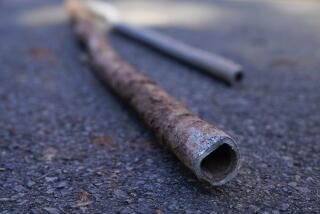Watch Your Ps and Qs When Replacing PVC
- Share via
I have been a professional property inspector in Southern California for several years. I read some dangerous advice given in your April 24, 1994 “Handyman Q&A;” column and would like (to) offer some information to your readers.
The question was: I’m replacing some bad sections of copper pipe. Can I use PVC pipe for the repairs?
The column answer simply described connection methods, never bringing up the fact that the repairs would probably not meet the building code requirements and may in fact create a severe electrical hazard.
As the question was relating to copper pipe, one must assume the lines in question were for the potable plumbing supply system. PVC (polyvinyl chloride) is not an approved material by the Uniform Plumbing Code or any municipality that I am aware of, for pressurized systems within the building. This includes lines located in crawl spaces and attics. PVC is generally accepted for use as supply for irrigation systems and potable supply outside the building’s framework. In all likelihood the repairs in question would be in a location where PVC is not accepted, so if you were to follow the advice of the column, you would be performing a “nonconforming” or “improper” repair.
Secondly, and most important, a large percentage of homes use the potable plumbing supply system as the grounding source in the electrical system. A home’s grounding system is generally the most important component of the system as it is designed to protect the occupants from electrical shock. PVC is made of plastic, even in approved locations, can eliminate the grounding source, thus creating a potential electrical hazard of lethal proportions.
SCOTT CLEMENTS
President, Inland Empire Chapter,
Calif. Real Estate Inspection Assn.
More to Read
Inside the business of entertainment
The Wide Shot brings you news, analysis and insights on everything from streaming wars to production — and what it all means for the future.
You may occasionally receive promotional content from the Los Angeles Times.









